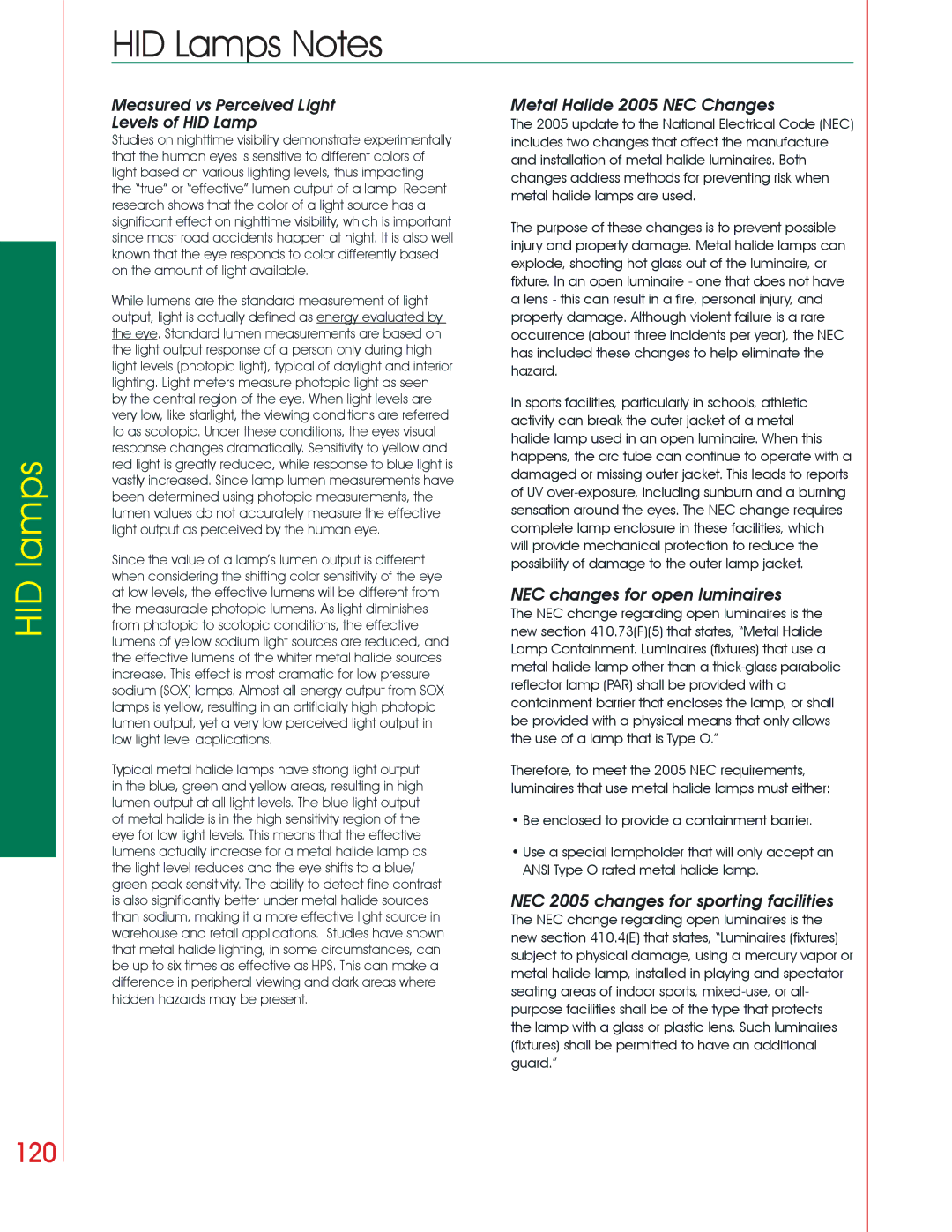Measured vs Perceived Light
Levels of HID Lamp
Studies on nighttime visibility demonstrate experimentally that the human eyes is sensitive to different colors of light based on various lighting levels, thus impacting the “true” or “effective” lumen output of a lamp. Recent research shows that the color of a light source has a significant effect on nighttime visibility, which is important since most road accidents happen at night. It is also well known that the eye responds to color differently based on the amount of light available.
While lumens are the standard measurement of light output, light is actually defined as energy evaluated by the eye. Standard lumen measurements are based on the light output response of a person only during high light levels (photopic light), typical of daylight and interior lighting. Light meters measure photopic light as seen by the central region of the eye. When light levels are very low, like starlight, the viewing conditions are referred to as scotopic. Under these conditions, the eyes visual response changes dramatically. Sensitivity to yellow and red light is greatly reduced, while response to blue light is vastly increased. Since lamp lumen measurements have been determined using photopic measurements, the lumen values do not accurately measure the effective light output as perceived by the human eye.
Since the value of a lamp’s lumen output is different when considering the shifting color sensitivity of the eye at low levels, the effective lumens will be different from the measurable photopic lumens. As light diminishes from photopic to scotopic conditions, the effective lumens of yellow sodium light sources are reduced, and the effective lumens of the whiter metal halide sources increase. This effect is most dramatic for low pressure sodium (SOX) lamps. Almost all energy output from SOX lamps is yellow, resulting in an artificially high photopic lumen output, yet a very low perceived light output in low light level applications.
Typical metal halide lamps have strong light output in the blue, green and yellow areas, resulting in high lumen output at all light levels. The blue light output of metal halide is in the high sensitivity region of the eye for low light levels. This means that the effective lumens actually increase for a metal halide lamp as the light level reduces and the eye shifts to a blue/ green peak sensitivity. The ability to detect fine contrast is also significantly better under metal halide sources than sodium, making it a more effective light source in warehouse and retail applications. Studies have shown that metal halide lighting, in some circumstances, can be up to six times as effective as HPS. This can make a difference in peripheral viewing and dark areas where hidden hazards may be present.
Metal Halide 2005 NEC Changes
The 2005 update to the National Electrical Code (NEC) includes two changes that affect the manufacture and installation of metal halide luminaires. Both changes address methods for preventing risk when metal halide lamps are used.
The purpose of these changes is to prevent possible injury and property damage. Metal halide lamps can explode, shooting hot glass out of the luminaire, or fixture. In an open luminaire - one that does not have a lens - this can result in a fire, personal injury, and property damage. Although violent failure is a rare occurrence (about three incidents per year), the NEC has included these changes to help eliminate the hazard.
In sports facilities, particularly in schools, athletic activity can break the outer jacket of a metal halide lamp used in an open luminaire. When this happens, the arc tube can continue to operate with a damaged or missing outer jacket. This leads to reports of UV over-exposure, including sunburn and a burning sensation around the eyes. The NEC change requires complete lamp enclosure in these facilities, which will provide mechanical protection to reduce the possibility of damage to the outer lamp jacket.
NEC changes for open luminaires
The NEC change regarding open luminaires is the new section 410.73(F)(5) that states, “Metal Halide Lamp Containment. Luminaires (fixtures) that use a metal halide lamp other than a thick-glass parabolic reflector lamp (PAR) shall be provided with a containment barrier that encloses the lamp, or shall be provided with a physical means that only allows the use of a lamp that is Type O.”
Therefore, to meet the 2005 NEC requirements, luminaires that use metal halide lamps must either:
•Be enclosed to provide a containment barrier.
•Use a special lampholder that will only accept an ANSI Type O rated metal halide lamp.
NEC 2005 changes for sporting facilities
The NEC change regarding open luminaires is the new section 410.4(E) that states, “Luminaires (fixtures) subject to physical damage, using a mercury vapor or metal halide lamp, installed in playing and spectator seating areas of indoor sports, mixed-use, or all- purpose facilities shall be of the type that protects the lamp with a glass or plastic lens. Such luminaires (fixtures) shall be permitted to have an additional guard.”

